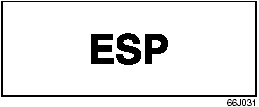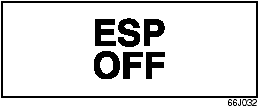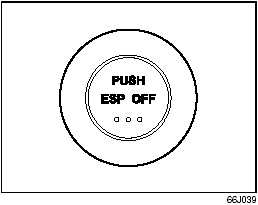Electronic Stability Program (ESP®)
ESP® is a registered trademark of DaimlerChrysler AG.
The Electronic Stability Program (ESP®) helps to control the vehicle during cornering if the vehicle is understeering or oversteering.
It also assists you in maintaining traction while accelerating on loose or slippery road surfaces. It does this by regulating the engine’s output, and by selectively applying the brakes. In addition, ESP® helps to avoid skidding by controlling braking pressure.
 WARNING:
WARNING:
The ESP® cannot enhance the vehicle’s
driving stability in all situations
and does not control your vehicle’s
entire braking system. The ESP® cannot
prevent accidents, including
those resulting from excessive speed
in turns, or hydroplaning. Only a safe
and attentive driver can prevent accidents.
The capabilities of an ESP®- equipped vehicle must never be used as a substitute for careful driving.
The ESP® has the following three systems:
Stability Control System
The vehicle stability control system helps provide integrated control of systems such as anti-lock brakes, traction control, engine control, etc. This system automatically controls the brakes and engine to help prevent the vehicle from skidding when cornering on a slippery road surface or when turning the steering wheel abruptly.
Traction Control System
The traction control system automatically helps prevent the spinning of wheels when the vehicle is started or accelerated on slippery road surfaces. The system operates only if it senses that some of the wheels are spinning or beginning to lose traction. When this happens, the system operates the front or rear brakes and reduces engine power to limit wheel spin.
NOTE:
You may hear a clicking sound in the
engine compartment for a few seconds
when you start the engine or just after the
vehicle begins to move. This means that
the above systems are in the self-check
mode. This sound does not indicate a malfunction.
Anti-Lock Braking System (ABS)
ABS will help you avoid skidding by electronically controlling braking pressure. It will also help you maintain steering control when braking on slippery surfaces or when braking hard. The ABS works automatically, so you do not have to use any special braking technique. Just push the brake pedal down without pumping. The ABS will operate whenever it senses that wheels are locking up. You may feel the brake pedal pulsate while the ABS is operating.
(For more information on ABS, see “Braking” in the “OPERATING YOUR VEHICLE” section.)
NOTE:
If the ABS system is activated, you may
hear a clunking noise and/or feel pulsating
in the brake pedal. This is normal and indicates
that the brake fluid pressure is being
controlled properly.
 WARNING:
WARNING:
• The ESP® may not work properly if
tires or wheels other than those
specified in the Owner’s Manual are
used. When replacing tires or
wheels, use only the size and type
specified in this Owner’s Manual.
• The ESP® may not work properly if tires are not inflated to the recommended tire inflation pressure.
• The ESP® may not work properly if tires are fitted with tire chains.
• The ESP® may not work properly if the tires are excessively worn. Be sure to replace tires when the tread wear indicators in the grooves appear on the tread surface.
• The ESP® is not a substitute for winter tires or tire chains on a snow covered road.
 WARNING:
WARNING:
• The ESP® may not work properly if
engine related parts such as the
muffler are not equivalent to standard
equipment or are extremely
deteriorated.
• Do not modify the vehicle’s suspension
since the ESP® may not
operate correctly.
The ESP® indicator lights are described below:

SLIP Indicator Light
When one of the ESP® systems other than ABS is activated, the SLIP indicator light in the instrument cluster blinks 5 times per second.
CAUTION:
If the SLIP indicator light comes on
and stays on while driving, there may
be a malfunction of the ESP® systems
(other than ABS). You should
have the systems inspected by an
authorized SUZUKI dealer.
NOTE:
When the SLIP indicator light comes on
and stays on while driving, indicating a
malfunction of the ESP® systems (other
than ABS), the brake system will function
as an ordinary ABS with no additional
ESP® functions.
NOTE:
When you disconnect and re-connect the
battery, ESP® system functions other than
ABS will be deactivated and the slip indicator
light will blink 1 time per second. In this
case, use the following procedure to reactivate
the ESP® systems:
1) Drive your vehicle straight ahead without
tire slippage at a speed greater than
approximately 15 km/h (9 mph) for a
few seconds
2) The slip indicator light will go out and
the ESP® systems (other than ABS) will
be re-activated
It may take more than few seconds before
the slip indicator light goes out depending
on the road surface condition.

“ESP” Warning Light
When the ESP® systems (other than ABS) have a system malfunction, the “ESP” warning light in the instrument cluster comes on.
CAUTION:
If the “ESP” warning light comes on,
or stays on while driving, there may
be a malfunction of the ESP® systems
(other than ABS). You should
have the systems inspected by an
authorized SUZUKI dealer.
NOTE:
When the “ESP” warning light comes on,
or stays on while driving, indicating a malfunction
of the ESP® systems (other than
ABS), the brake system will function as an
ordinary ABS that has no additional ESP®
functions.

“ESP OFF” Indicator Light
You should turn the ESP® on during your ordinary driving, so that you have the benefits of all of the ESP® systems.
It may be required to turn the ESP® systems (other than ABS) off if your vehicle is stuck in sand, mud, or snow, or when driving in extreme off-road conditions where wheel spin is necessary.

“ESP OFF” switch
When the “ESP OFF” switch located at the center of the instrument panel is pushed and held to turn off the ESP® systems (other than ABS), the “ESP OFF” indicator light in the instrument cluster comes on.
When you push and hold the “ESP OFF” switch again, the “ESP OFF” indicator light will go out and all of the ESP® systems will be activated.
NOTE:
• When the vehicle speed is greater than
approximately 30 km/h (19 mph), the
ESP® systems (other than ABS) will turn
on automatically and the “ESP OFF”
indicator light will go out.
• When the transfer switch (if equipped) is turned to the “4L LOCK” position, the ESP® systems (other than ABS) will be canceled to provide improved vehicle traction, and the “ESP OFF” indicator light will come on.
When the transfer switch (if equipped) is turned to the “4L LOCK” position, braketraction control can be activated. Braketraction control brakes the spinning wheel to distribute drive power to the other wheels for increased climbing ability or for better performance on a rolling hill or a slippery surface.
• If the ESP® systems operate continuously, such as when driving on slippery roads, the traction control functions of the ESP® systems may be canceled temporarily to avoid overheating the brake pads, and the “ESP OFF” indicator light will come on. After a short period of time, the ESP® systems (other than ABS) will turn on automatically and the “ESP OFF” indicator light will go out.
ABS Warning Light / Brake System Warning Light
See “Braking” in the “OPERATING YOUR VEHICLE” section.
See also:
2010 Suzuki SX4 review By Dan Neil
It's a well-known principle of quantum mechanics that racing stripes make a
car faster. Depending on the width and color of the stripes, accessorizing paint
schemes can shave 2 seconds off the qua ...
Rear Window Wiper/Washer Switch
Rear Window Wiper/Washer Switch
To turn the rear wiper on, twist the rear
wiper switch on the end of the lever forward
to the “ON” position. If your vehicle is
equipped the “INT” positio ...
Headlight Aiming
Since special procedures are required, we
recommend you take your vehicle to your
SUZUKI dealer for headlight alignment. ...
